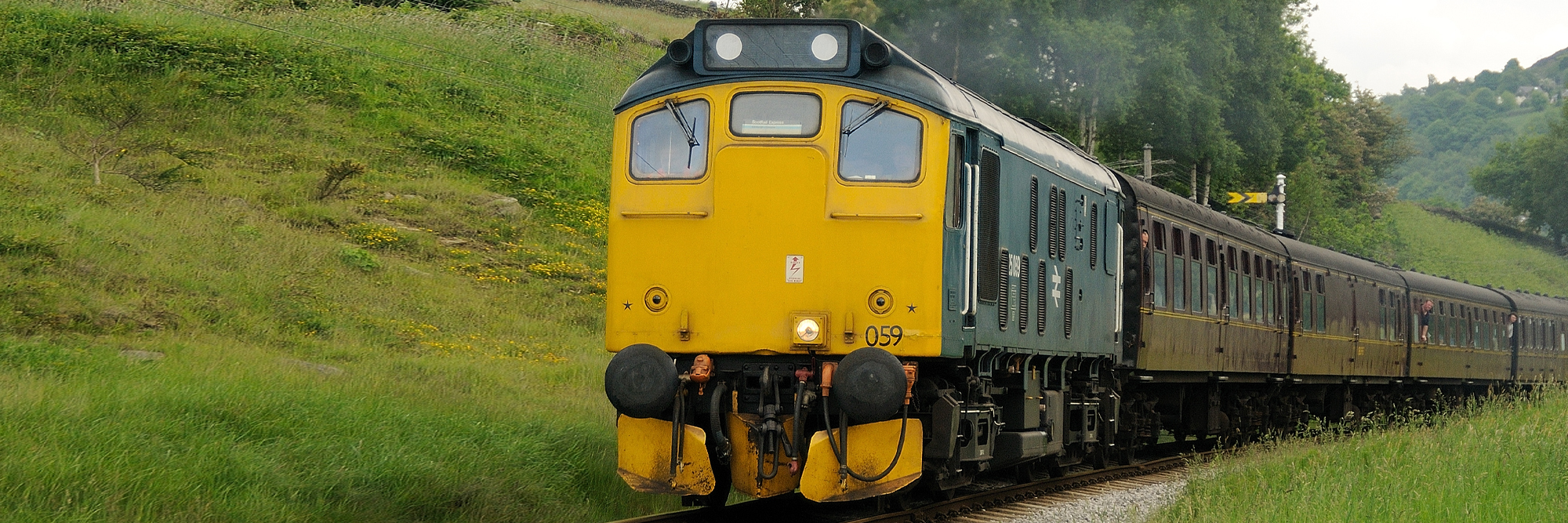A versatile freight locomotive, often used on passenger duties
A successful first generation Type 2, these locomotives served the network well for over 25 years until withdrawn when the type of work for which they were designed or replaced by more modern machines. Popular with preserved lines, 20 have entered preservation, although not all are operational.
Saved from under the nose of the cutters torch
Like many steam locomotives, diesels no longer needed on the national network have now spent more time in preservation than they did on the mainline. 25 059 was 24 years in national service and in 2020 has been at Haworth for 33. Over that time it has required a lot of tlc and is now awaiting its next overhaul.
Data File
Built: 1963 Derby
Engine: Sulzer 6LDA28B of 930kW (1,250hp) at 750rpm
Transmission: Electric. Four AEI 253AY axle-hung traction motors
Power at Rail: 708 kW (949 hp)
Weight: 76 Tonnes
Max Speed: 90 mph
Max. T.E.:2OO kN (45,000 lbf.)
Cont. T.E.: 93kN (20,800 lbf.) at 17.1 mph
Numbers carried during working career: D5209, 25059
Outshopped from Derby as the Worth Valley was gearing up for preservation
This engine was developed under the BR modernisation plan of 1955. British Rail, in its haste to rid the network of steam locomotion, ordered small numbers of various types for testing. The Type 2 evolved from one of the more successful prototypes and went into production.
The Class 25 locos were primarily designed for freight work, but were also regulars on passenger workings, some being fitted with steam heating boilers. Throughout their lives they could be found at work across the whole network although the Eastern and Southern Regions did not receive an allocation.
No. D5209 was built by BR at Derby in 1963 and went new to Toton Depot in Nottinghamshire. After working in the London Midland Region, it moved to the Western Region before being transferred to the Scottish Region between 1976 and 1982. In October 1982, as by then a member of Class 25 and numbered 25 059, it returned to England, being based at Crewe Diesel Depot. It worked until the very end of Class 25 workings, being withdrawn from Buxton on 22nd March 1987, this being the last year of Class 25 operation. Two days later, however, the engine was returned to service to haul a Class 47 and a Class 37 to Crewe from where it was finally withdrawn from traffic.
A most useful addition to the fleet
After being sold for scrap to a dealer in Leicestershire, a private group of individuals purchased the engine for use on the Worth Valley Railway and, as the first mainline diesel to arrive on the Railway, has a special place in KWVR history. This group in turn donated the engine to the Keighley and Worth Valley Railway Preservation Society. It worked its first trial runs on the KWVR on 10th October 1987.
During its stay on the KWVR the engine has carried both British Railways green and, currently (2020), British Rail blue liveries and has worked regular passenger services, works-trains, demonstration freight duties and other special events, especially the tail of the top and tailed Santa Steam Specials.
25 059 is now stopped and stored in Haworth shed awaiting overhaul. Although serviceable it was recognised the wiring needed replacing and the bogies a full overhaul. However, the floods caused by Storm Ciara in February 2019 left us relatively unscathed in terms of overall damage but 25 059 did not fare well and was immediately laid aside, unserviceable.
